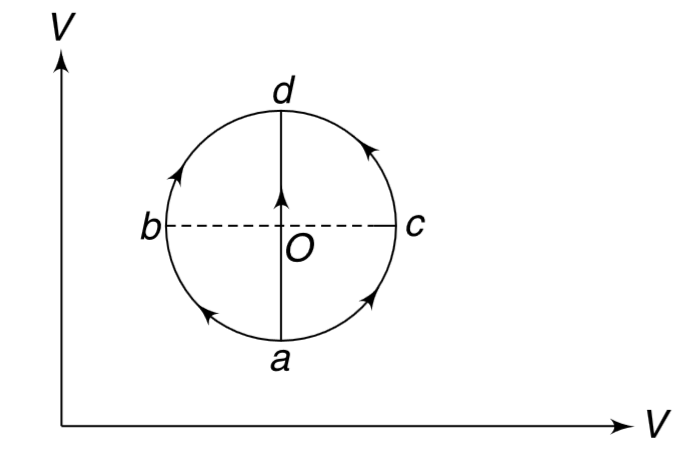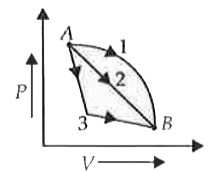An ideal gas of mass m in a state A goes to another state B via three different processes as shown in Fig. If Q1,Q2 and Q3 denote the heat absorbed by the gas along the three paths, then

Q1<Q2<Q3
Q1<Q2=Q3
Q1=Q2>Q3
Q1>Q2>Q3
The correct Answer is:A
a. Area enclosed by curve 1 lt area enclosed b curve 2 lt Area enclosed by curve 3
∴Q1<Q2<Q3 (As ΔU is same for all the curves)
Topper's Solved these Questions
- KINETIC THEORY OF GASES AND FIRST LAW OF THERMODYNAMICSBOOK - CENGAGE PHYSICSCHAPTER - KINETIC THEORY OF GASES AND FIRST LAW OF THERMODYNAMICSEXERCISE - Multiple Corrects
29 Videos
- KINETIC THEORY OF GASES AND FIRST LAW OF THERMODYNAMICSBOOK - CENGAGE PHYSICSCHAPTER - KINETIC THEORY OF GASES AND FIRST LAW OF THERMODYNAMICSEXERCISE - Assertion-Reasoning
6 Videos
- KINETIC THEORY OF GASES AND FIRST LAW OF THERMODYNAMICSBOOK - CENGAGE PHYSICSCHAPTER - KINETIC THEORY OF GASES AND FIRST LAW OF THERMODYNAMICSEXERCISE - Subjective
22 Videos
- KINETIC THEORY OF GASESBOOK - CENGAGE PHYSICSCHAPTER - KINETIC THEORY OF GASESEXERCISE - Compression
2 Videos
- LINEAR AND ANGULAR SIMPLE HARMONIC MOTIONBOOK - CENGAGE PHYSICSCHAPTER - LINEAR AND ANGULAR SIMPLE HARMONIC MOTIONEXERCISE - Multiple Correct Answer Type
9 Videos
Similar Questions
A given mass of gas expands from state A to state B by three paths 1, 2 and 3 as shown in the figure

If w1,w2andw3 respectively are be the works done by the gas along three paths, then
View SolutionAn ideal gas is taken from its initial state a to its find state d in three different quasi static processes marked as a – b – d, a – o – d and a – c – d. Rank the net heat absorbed by the gas in the three processes. The diagram shown is a circle with centre at o.

View Solution
Knowledge Check
An ideal gas goes from state A to state B via three different processes as indicated in the P-V diagram. If Q1,Q2,Q3 indicate the heat absorbed by the gas along the three processes and ΔU1,ΔU2,ΔU3 indicate the change in internal energy along the three processes respectively, then
 AQ1>Q2>Q3 and ΔU1=ΔU2=ΔU3BQ1>Q2>Q3 and ΔU1=ΔU2=ΔU3CQ1=Q2=Q3 and ΔU1>ΔU2>ΔU3DQ3>Q2>Q1 and ΔU1>ΔU2>ΔU3
AQ1>Q2>Q3 and ΔU1=ΔU2=ΔU3BQ1>Q2>Q3 and ΔU1=ΔU2=ΔU3CQ1=Q2=Q3 and ΔU1>ΔU2>ΔU3DQ3>Q2>Q1 and ΔU1>ΔU2>ΔU3An ideal gas goes from State A to state B via three different process as indicate in the P−V diagram.

If Q2,Q3 indicates the heat absorbed by the gas along the three processes and ΔU1,ΔU2,ΔU3 indicates the change in internal energy along the three processes respectively, thenAQ1>Q2>Q3 and ΔU1=δU2=ΔU3BQ3>Q2>Q1 and ΔU1=ΔU2=ΔU3CQ1=Q2=Q1 and ΔU1>ΔU2>ΔU3DQ3>Q2Q1 and ΔU1>ΔU2>ΔU3A given mass of a gas expands from the state A to the state B by three paths 1,2 and 3 as shown in the figure, If W1,W2 and W3 respectively be the work done by the gas along the three paths then
 AW1>W2>W3BW1<W2<W3CW1=W2=W3DW1<W2=W3
AW1>W2>W3BW1<W2<W3CW1=W2=W3DW1<W2=W3
A givne mass of a gas expands from a state A to the state B by three paths 1, 2 and 3 as shown in T-V indicator diagram. If W1,W2 and W3 respectively be the work done by the gas along the three paths, then

View SolutionA given mass of a gas expands ffrom a state A to the state B by three paths 1,2
and 3 as shown in T-V indicator diagram. If W1,W2andW3 respectively be
the work done by the gas along the three paths, then
View SolutionA given mass of gas expends from the state A to the state B by three paths 1,2 and 3 as shown in the figure. If w1,w2 and w3 respectively be the magnitude of worl done by the gas along three paths then :

View SolutionA given mass of gas expands from state A to state b by three paths 1,2, and 3 as shown in the figure below. If w1,w2 and w3, respectively, be the work done by the gas along three paths, then

View SolutionA given mass of gas expands from state A to state B by three paths 1, 2 and 3 as shown in the figure

If w1,w2andw3 respectively are be the works done by the gas along three paths, then
View Solution
